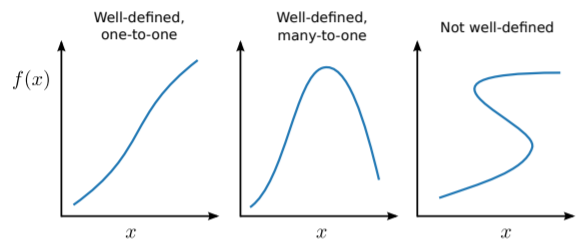1.1: Real Functions
( \newcommand{\kernel}{\mathrm{null}\,}\)
A mathematical function, denoted f, takes an input x (which is also called an argument), and returns an output f(x). For now, we consider the case where both x and f(x) are real numbers. The set of possible inputs is the function’s domain, and the set of possible outputs is the range.
Every function must have a well-defined output: for any x in the domain, f(x) must be a specific, unambiguous number. In other words, a function must be either a one-to-one (injective) mapping or a many-to-one mapping; the mapping cannot be one-to-many or many-to-many:

Simple examples of functions are those based on elementary algebra operations: f(x)=x+2(a one-to-one function)f(x)=x2+2x+4(a many-to-one function)


